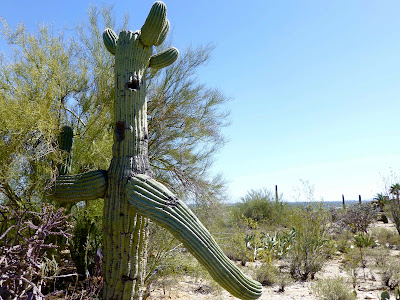Since being in Tucson I've gained an appreciation of the amazing desert sentinel, the Saguaro. This is the iconic cactus from the cartoons and the cowboy movies. It grows at a specific altitude in areas of Arizona, California and Northern Mexico.
This one stands in front of the house we're staying in and to me it looks like a Hopi Kachina twirling in a dance. She's an old one for sure as they grow very slowly. It takes up to 75 years for them to develop a side arm.
Nobody knows why some of them grow straight up like sentinels while others grow as many as twenty arms. But this difference makes them so fascinating and appealing. Each Saguaro develops its own character as it grows and ages.
Here's another view of our Saguaro (we've named her Hopi), showing some other holes that give her her expression. These holes are made by Gila Woodpeckers and other desert birds.
Apparently the birds peck through the hard skin into the softer areas and create the size of hole they need, then they leave for a few weeks, during which time the cactus forms scar tissue that creates a perfect nest. After the larger birds have left these holes, they're used by other birds like owls and wrens.
Here are a few other Saguaros. The one on the right has an unusual twist to it. The smaller ones on the left might be about 30 years old.
Sometimes instead of developing arms the saguaro will develop what's called a crest at its top. Doesn't this one look as if its wearing a crown?
In spring saguaros hold a lot of water in their spongy core and their pleated skin expands. The big ones can hold hundreds of gallons of water. Also in the spring they develop buds that become blooms. I've yet to see one of these but I have my fingers crossed.

These amazing plants are spread by tiny seeds from the fruit that birds eat. They can live as long as 150 years. Some of the older ones look dead but still put out new buds and flowers. These buds are from the end of the arm of the ancient one in our yard that we call Hopi.
When the plant dies it starts to reveal its inner structure. You can see the ribs, which have been used for centuries to build shelters.

One final thing, many saguaros stand close to the palo verde tree and the reason for this is that the seeds and tiny seedlings are sheltered by these trees during their vulnerable period. Now you know a bit about the saguaro story. Do you see why I'm so fascinated?











Quite a remarkable plant!
ReplyDelete